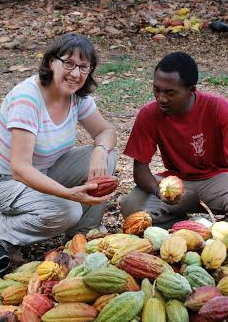Farming First is pleased to act as media partner for the Louis Malassis International Scientific Prize and the inaugural Olam Prize for Innovation in Food Security. Our blog series has showcased stories from scientists nominated for these prestigious prizes.
The final blog in this series outlines the work of Dr. Claire Lanaud, nominated for the Louis Malassis International Scientific Prize for Distinguished Scientist.
Global demand for chocolate is increasing. This, in the context of a changing climate is putting pressure on cocoa farmers and chocolate manufacturers to increase both the quantity and quality of their products.
Dr. Claire Lanaud, nominee for the Louis Malassis International Scientific Prize for Distinguished Scientist, is an expert in cocoa genetics, and her work seeks to improve cocoa varieties, thereby contributing to the sustainable development of agriculture in the Southern hemisphere.
“The tropical species are generally less studied than European ones,” comments Dr. Lanaud. “Our objectives were to use the latest technologies and high throughput analysis tools to progress more rapidly in their knowledge and share it with all the cocoa community.”
Dr. Lanaud and her team were among the pioneers that developed molecular tools dedicated to tropical crop studies, and more specifically to T. cacao. The team initiated and coordinated the production of the first whole genome sequence of cocoa ever published, which is particularly useful to identify key genes involved in traits of interest, such as disease resistance, yield and quality traits, which can improve breeding strategies. The team made all these molecular resources publically available, facilitating international collaborations.
A large part of Dr. Lanaud’s research has also been dedicated to the study of genetic resources diversity and domestication, and particularly those related to the two fine flavour cocoa varieties: Criollo, and Nacional. With her team, her research has resulted in the identification of the ancestral variety, and in the identification of the region of origin for the Nacional variety from Ecuador. “This enabled us to conduct subsequent research and rescue wild and native cocoa trees from this region, now held in germplasm collections, for the improvement of cocoa aromatic varieties,” comments Dr. Lanaud.
Hybrid cocoa seeds, produced in seed gardens are the improved cocoa materials that are distributed most widely. One early application of the marker tools developed by Dr. Lanaud’s team was to show the instability of the cocoa incompatibility system, a biological system that prevents the female parent to be self-pollinated and to produce self seeds if totally active. Dr Lanaud’s team was able to discover this was not the case. This work had a direct and short-term impact on the quality of improved material distributed to farmers, resulting in an increase to farmers’ yield and income.
“Our work on the sources of disease resistance has also provided valuable information to define better strategies to increase and establish a sustainable production while reducing reliance on pesticides,” says Dr. Lanaud.
Dr. Lanaud and her team’s work on cocoa genetic resources knowledge will contribute to the preservation of cocoa genetic resources. “This is particularly important in a context of climatic changes, to have access to new genes that allow adaptation,” comments Dr. Lanaud. “This is an important economic issue, particularly for Ecuador, for the improvement of its ‘Nacional’ aromatic cocoa variety that is widely exported.”
This work, which has always been conducted in partnership with many other organisations, has been widely disseminated through congresses, international publications and interactions with civil society, facilitating the exchange of information between several cocoa research centers to progress more rapidly in cocoa improvement.
“My experience in African countries, and my collaborations with partners of in both the Northern and Southern hemisphere and with all actors of the cocoa chain was particularly enriching for me both on a professional and personal level,” says Dr. Lanaud.
“Our mutual viewpoints and our complementary approaches around cocoa cultivation and improvement have opened new fields of knowledge for me, which provided new opportunities to progress and constantly renewed my interest to contribute to the sustainable development of agriculture.”
The winners of the Louis Malassis International Scientific Prize and Olam Prize for Innovation in Food Security, will be announced at the Third Global Science Conference on Climate Smart Agriculture on 16th March, 2015.




